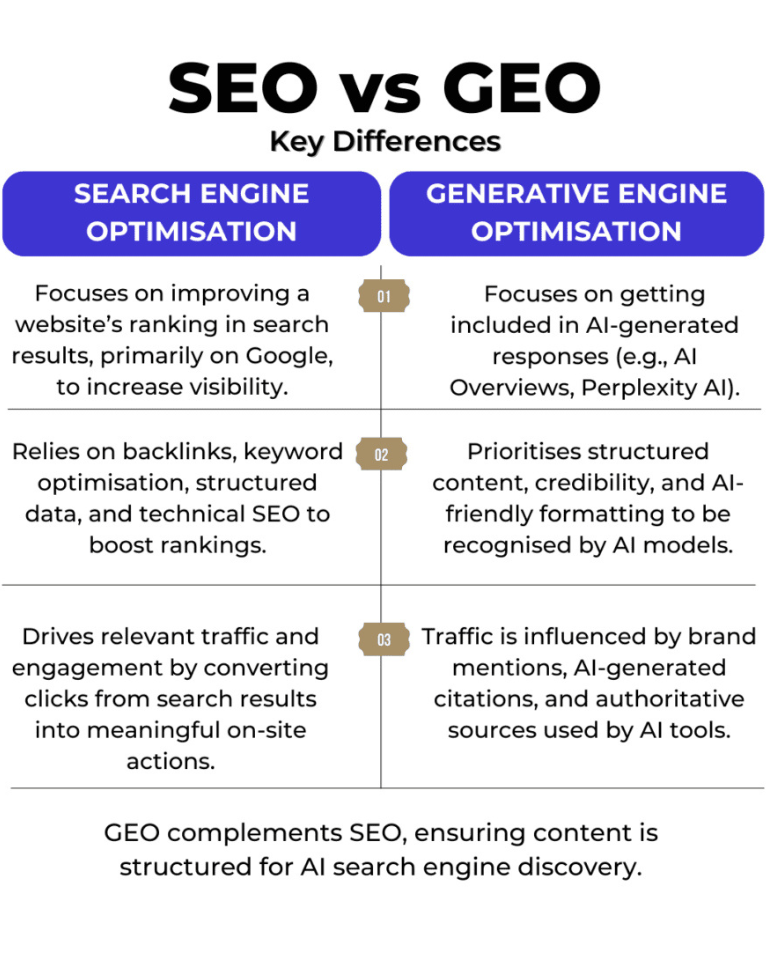GEO Takes Over: SEO for the Age of ChatGPT and AI
GEO Takes Over: SEO for the Age of ChatGPT and AI
In the past, when people talked about search engine optimization (SEO), they meant improving websites so they rank better on Google. But now, a new trend is changing everything Generative Engine Optimization (GEO).
With the rise of AI tools like ChatGPT, Google’s AI Overviews, Bing Copilot, and others, users are no longer just typing into a search bar and clicking links. Instead, they’re getting AI-generated answers instantly.
So the big question is:
How do businesses show up in these AI-generated answers?
That’s what GEO is all about.
What is GEO (Generative Engine Optimization)?
GEO stands for Generative Engine Optimization. It’s the process of optimizing your content so that it appears in the answers given by AI-powered search tools like ChatGPT, Google’s SGE (Search Generative Experience), and Bing’s AI.
Instead of competing for the top spot on a traditional Google search results page, GEO is about making sure your content is cited, referenced, or included in AI answers.
Think of it this way:
🧠 SEO = Optimizing for search engines
🤖 GEO = Optimizing for generative AI engines
Why GEO Matters in 2025 and Beyond
The internet is changing fast. Here’s why GEO is important right now:
1. AI is the new gatekeeper
- AI tools are replacing traditional search for many users.
- People ask ChatGPT and Bing AI questions instead of Googling them.
- If your content isn’t appearing in AI answers, you’re invisible to a growing audience.
2. Featured snippets are declining
- AI results are replacing “position zero” (the featured snippet in Google).
- AI Overviews often summarize content from multiple sites GEO helps ensure your site is one of them.
3. Zero-click searches are rising
- More people are getting their answers without clicking.
- GEO helps ensure you’re still part of the conversation even if users don’t visit your site directly.
How Does Generative Engine Optimization Work?
Generative AI tools pull information from high-authority, trusted, and well-structured websites to generate answers.
So GEO involves:
- Creating valuable, credible content that AI models can understand and trust.
- Structuring content in a way that’s easy for AI to summarize.
- Using keywords and topics that align with user questions, not just search phrases.
In other words, you’re not just writing for Google anymore you’re writing for robots that think like humans.
Also Read: How to Use Google Search Console to Improve Your SEO
Key Elements of a GEO Strategy
Let’s break it down into practical steps to help you get started.
1. Focus on topical authority
- AI tools prefer sites that go deep on a subject.
- Don’t write one blog post about SEO create a series on SEO topics.
- Become a subject-matter expert in your niche.
Tip: Use topic clusters (one main pillar page + related posts).
2. Structure content like an AI would understand
- Use clear headings (H1, H2, H3) and bullet points.
- Write in short, simple sentences.
- Include definitions, examples, pros/cons, and FAQs.
Why? Because AI models love clean, organized, and readable content.
3. Use natural language questions and answers
- AI tools are trained on human-like questions.
- Include Q&A sections in your blogs.
- Write like you’re answering a question someone typed into ChatGPT.
Example:
Q: What is GEO in SEO?
A: GEO stands for Generative Engine Optimization. It means
4. Cite sources and link to credible content
- AI prefers content that includes references.
- Link to trusted industry websites (e.g., Google Blog, HubSpot, Moz).
- Back up stats and claims.
Bonus: This builds your E-E-A-T (Experience, Expertise, Authoritativeness, Trustworthiness).
5. Answer “people also ask” style queries
- Go to Google and search your topic.
- Note the “People also ask” box.
- Include answers to those questions in your content.
Example:
Include questions like:
- How is GEO different from traditional SEO?
- Is GEO better than SEO?
6. Stay updated with AI changes
- Follow updates from Google’s Search Generative Experience (SGE), OpenAI, Bing, and Perplexity.
- AI is evolving fast, so what works today may not work tomorrow.

Real-Life Example of GEO in Action (2025)
Let’s say you run a website about skincare. You write a blog post titled:
“How to Treat Oily Skin in Summer: Dermatologist Tips”
Now, a user types into ChatGPT:
“How can I prevent oily skin in hot weather?”
If your blog is:
- Well-structured
- Full of helpful, natural language
- Cites credible sources
- Offers expert insights
There’s a good chance ChatGPT might summarize from your blog or even cite your website.
GEO vs SEO: What’s the Difference?
FeatureTraditional SEOGEO (Generative Engine Optimization)TargetSearch engines like GoogleAI models like ChatGPT, Gemini, Bing AIGoalRank high on results pagesBe used in AI-generated answersFormatKeywords, meta tags, backlinksClear, Q&A-style, well-structured contentCTRHigher from clickable linksLower (zero-click), but builds authorityStrategyOptimize for rankingOptimize for summarization + authority
Tools to Help with GEO
Here are some tools to help you optimize for AI answers:
- AlsoAsked : to find question-based search queries
- AnswerThePublic: discover what people are asking
- Surfer SEO : content optimization based on top results
- MarketMuse : builds topic authority and content clusters
- ChatGPT & Gemini : simulate AI-generated answers using your content
To know more about GEO (Generative Engine Optimization) Read our Article Now



Comments
Post a Comment